
Kontakt
 |
Newsletter Kontakt |
||||||
| Spots | Contests | People | Calendar | Forum | Links | ||
| Sk8Mag.de > People > Interview Attila Aszodi |
Deutsch |
||||||
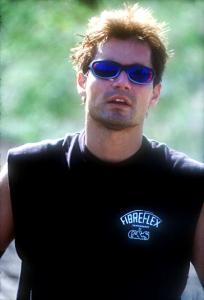
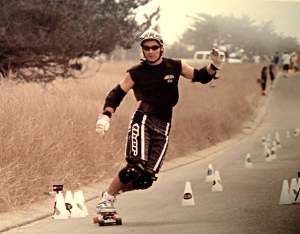
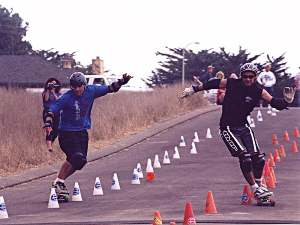 I met Debbie Gordon Saili in '99. To this point I didn't even know that G&S / Fibreflex was still in existence. One day
I saw a G&S longboard on ebay for sale, (which I ended up buying). It was exciting for me to see they were still around
that after all these years especially since I practically grew up riding these boards in the 70's. These new boards
were also being sold at various online retailers but all the boards G&S made were the newer longboard carving decks.
None of the classic freestyle or slalom shortboards were available or manufactured at that time.
As a matter of fact, no US skateboard manufacturer offered a slalom board at that time, period. Thanks to ebay, I was
able to start a vintage slalom collection so that I would be able to ride and compete again. Doing that was like going
back to my early riding days. It totally brought that feel back. I was completely hooked! I met some incredible people
during this time some of which never stopped skating through all these years. People I had heard of in
the 70's came from everywhere. In any case, I started collecting classic trucks and wheels as well since nothing that
was manufactured at the time was suitable for slalom.
Somehow I knew that the time was right to get new slalom gear on the market and I kept thinking, G&S needs to introduce
a new competition slalom board and re-introduce some of the old designs-the time for the classic vibe was right--I would
certainly love to be able to buy some of the reissues such as the kicktail, teamrider, hester and slalom models.
I always loved fibreflexes which to me was what skateboarding was all about--there was a certain weightlessness and ease
about these boards when you were riding them, a free spirit, sort of what I had envisioned California to be like when
I still lived in Germany.
I got Debbie's contact information online and called her one day. We immediately clicked and sometimes talked for hours,
reminiscing about the old days and how cool it would be if G&S started making the classic boards again. I told her that
there seems to be this ressurgence of slalom and old school skateboarding taking place and people just keep coming out
of the woodworks, some of them well known skaters. There was this underground racing scene developing, it was strange,
almost like an awakening that happened to many of us simultaneously.
She told me that she was actually getting ready to run the company and that one of her dreams was to start working on
the classic re issues. She was starting it all again all by herself and I told her that I would help her as a
photographer for her advertising needs and became a creative partner early on. At one point I suggested that G&S
should consider introducing a new pro level slalom board but still incorporating the classic fibreflex overtones.
She was very excited about this idea and asked me to come up with various designs. I had a good idea about what would
work and how the board should look. I presented her and her father, the legendary Larry gordon (who still is a zen-like
creative partner) several designs which would fit in with the classic reissues such as the classic slalom, slalom
cutaway and the Hester.
Larry and Deb picked the shape they liked most and several months later, after getting the specs and manufacturing down,
the "response" model was born. This was in April of 2001.
I met Debbie Gordon Saili in '99. To this point I didn't even know that G&S / Fibreflex was still in existence. One day
I saw a G&S longboard on ebay for sale, (which I ended up buying). It was exciting for me to see they were still around
that after all these years especially since I practically grew up riding these boards in the 70's. These new boards
were also being sold at various online retailers but all the boards G&S made were the newer longboard carving decks.
None of the classic freestyle or slalom shortboards were available or manufactured at that time.
As a matter of fact, no US skateboard manufacturer offered a slalom board at that time, period. Thanks to ebay, I was
able to start a vintage slalom collection so that I would be able to ride and compete again. Doing that was like going
back to my early riding days. It totally brought that feel back. I was completely hooked! I met some incredible people
during this time some of which never stopped skating through all these years. People I had heard of in
the 70's came from everywhere. In any case, I started collecting classic trucks and wheels as well since nothing that
was manufactured at the time was suitable for slalom.
Somehow I knew that the time was right to get new slalom gear on the market and I kept thinking, G&S needs to introduce
a new competition slalom board and re-introduce some of the old designs-the time for the classic vibe was right--I would
certainly love to be able to buy some of the reissues such as the kicktail, teamrider, hester and slalom models.
I always loved fibreflexes which to me was what skateboarding was all about--there was a certain weightlessness and ease
about these boards when you were riding them, a free spirit, sort of what I had envisioned California to be like when
I still lived in Germany.
I got Debbie's contact information online and called her one day. We immediately clicked and sometimes talked for hours,
reminiscing about the old days and how cool it would be if G&S started making the classic boards again. I told her that
there seems to be this ressurgence of slalom and old school skateboarding taking place and people just keep coming out
of the woodworks, some of them well known skaters. There was this underground racing scene developing, it was strange,
almost like an awakening that happened to many of us simultaneously.
She told me that she was actually getting ready to run the company and that one of her dreams was to start working on
the classic re issues. She was starting it all again all by herself and I told her that I would help her as a
photographer for her advertising needs and became a creative partner early on. At one point I suggested that G&S
should consider introducing a new pro level slalom board but still incorporating the classic fibreflex overtones.
She was very excited about this idea and asked me to come up with various designs. I had a good idea about what would
work and how the board should look. I presented her and her father, the legendary Larry gordon (who still is a zen-like
creative partner) several designs which would fit in with the classic reissues such as the classic slalom, slalom
cutaway and the Hester.
Larry and Deb picked the shape they liked most and several months later, after getting the specs and manufacturing down,
the "response" model was born. This was in April of 2001.
 Making a living at skateboarding, especially in slalom or racing is difficult,. there are only very few skaters such as
Biker Sherlock and Lee Dansey and a few others who, mostly because of the X-games or Gravity games, are able to market
and franchise their names on a lucrative level. But this is mostly downhill and luge racing. However, as the price
monies are increasing in pro slalom racing, I 'll be hopefully able to make a couple of bucks in the future--I still
have a few years ahead of me. All this has only just begun :0)
I make my living as full time photographer, shooting mostly people and events in Hollywood. Recently, I have also been
shooting for International Skateboarder Magazine Cover of Dec 2001 issue)and expanded my work to Skateboard advertising
(recent G&S fibreflex ads). I have been married since '92- no kids yet. (This is not true anymore: Baby Bianca
Isabella Aszodi arrived Sunday 24. 11. 2002 at 3:05 am , @ 8.3lbs / 20"'s.)
Making a living at skateboarding, especially in slalom or racing is difficult,. there are only very few skaters such as
Biker Sherlock and Lee Dansey and a few others who, mostly because of the X-games or Gravity games, are able to market
and franchise their names on a lucrative level. But this is mostly downhill and luge racing. However, as the price
monies are increasing in pro slalom racing, I 'll be hopefully able to make a couple of bucks in the future--I still
have a few years ahead of me. All this has only just begun :0)
I make my living as full time photographer, shooting mostly people and events in Hollywood. Recently, I have also been
shooting for International Skateboarder Magazine Cover of Dec 2001 issue)and expanded my work to Skateboard advertising
(recent G&S fibreflex ads). I have been married since '92- no kids yet. (This is not true anymore: Baby Bianca
Isabella Aszodi arrived Sunday 24. 11. 2002 at 3:05 am , @ 8.3lbs / 20"'s.)
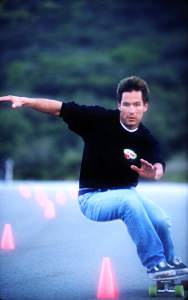 As for living here, you will realize after a while, that the level interpersonal contact is not as deep as in Germany.
Your daily exchange with most people is more superficial over here. People are friendly and smile more but it is more
on the surface. It seems that, because most people come to LA to be in Showbiz, they carry a chip on their shoulder,
something they have to overcome, something they have to prove, something they are very vulnerable about and they try
to cover that as much as possible by keeping a nice facade.
Friendships are difficult to make here and hard to maintain. Most of my friends are from outside of LA. The system
is quite different here as well. Insurance and health benefits are always an issue. Something that is well taken
care of in Europe most of the time. Vacation time at a job is much shorter (2 weeks usually), people eat heavier
breakfasts on weekends and dinner is never before 8pm, more people are on diets and yet there are more overweight
folks out here than anywhere else in the world. There are more contradictions to be found here than anywhere.
Americans thrive on controversy, that is what makes this country tick. It is also an extremely homophobic society.
People who are straight (not gay) make sure to let the rest know how straight they are. If you meet somebody new
and you want to be friends with them, a lot of times they might wonder if you're gay instead of saying hey, let's
be friends or what a nice person. You actually start thinking this way yourself, rather sad.
I remember when I moved here, the way guys dressed was rather pathetic, this was before Ralph Lauren and Banana
Republic come on the scene. There was no style, no attempt in wearing colors--pastels were practically outlawed,
if you didn't follow a certain trend you were either gay or weird. In Europe this was never the case, people
weren't afraid to express through their clothing.
Sexuality plays a key figure here in the US--it is so hyped up in the media that you might think that America
is an extremely open and comfortable country, sexually. But the pathetic reality is that sex is looked upon
as something almost forbidden, there are so many laws that will put you in jail because you took your shirt
off in public, or you made a false remark to a coworker, or you looked at somebody in a different way.
You will never see nudity on TV, no topless commercials for soaps or shampoos. In Europe, people are
comfortable with their sexuality, they don't mind showing their bodies, it is something natural and not
weird--here it is something that is very suppressed. Yet, people more about sex and express more about
sex in movies and music than any other country in the world. It is the strange and mysterious American
paradox. I am still trying to understand it--somebody once told me that this general attitude traces
back to the pilgrims who came to America- extremely prudent and conservative, their presence is still
being felt around the country. You can think out loud but you cannot act out loud!
Another difference to Europe is also the fact that people don't walk around here, everybody has a car and
uses a car to go shopping or to work. Again, LA is a different case since it is very large city but one
thing that is distinctively different is that this city has no core, no city as in most European cities,
no center where people just walk or just hang out at cafes.
Only recently, mainly because of Starbucks and all the coffee houses opening, people are starting to absorb
more of a European street style (they don't even know it :-0).
I miss walking in the city and looking at old architecture, I miss seeing culture wherever I turn or look at.
You are surrounded by it in Europe. Here, you see new malls and flat buildings and convenient stores. I miss
running into friends on the street and just going to a cafe and talk. I miss the weather (strange right?).
I miss my family. I miss being able to hitch hike or just hop on the train and be in another country within 2 hours.
Now I also miss Paris and being able to be at the Trocadero within 5 hours and set up a slalom course.
As for living here, you will realize after a while, that the level interpersonal contact is not as deep as in Germany.
Your daily exchange with most people is more superficial over here. People are friendly and smile more but it is more
on the surface. It seems that, because most people come to LA to be in Showbiz, they carry a chip on their shoulder,
something they have to overcome, something they have to prove, something they are very vulnerable about and they try
to cover that as much as possible by keeping a nice facade.
Friendships are difficult to make here and hard to maintain. Most of my friends are from outside of LA. The system
is quite different here as well. Insurance and health benefits are always an issue. Something that is well taken
care of in Europe most of the time. Vacation time at a job is much shorter (2 weeks usually), people eat heavier
breakfasts on weekends and dinner is never before 8pm, more people are on diets and yet there are more overweight
folks out here than anywhere else in the world. There are more contradictions to be found here than anywhere.
Americans thrive on controversy, that is what makes this country tick. It is also an extremely homophobic society.
People who are straight (not gay) make sure to let the rest know how straight they are. If you meet somebody new
and you want to be friends with them, a lot of times they might wonder if you're gay instead of saying hey, let's
be friends or what a nice person. You actually start thinking this way yourself, rather sad.
I remember when I moved here, the way guys dressed was rather pathetic, this was before Ralph Lauren and Banana
Republic come on the scene. There was no style, no attempt in wearing colors--pastels were practically outlawed,
if you didn't follow a certain trend you were either gay or weird. In Europe this was never the case, people
weren't afraid to express through their clothing.
Sexuality plays a key figure here in the US--it is so hyped up in the media that you might think that America
is an extremely open and comfortable country, sexually. But the pathetic reality is that sex is looked upon
as something almost forbidden, there are so many laws that will put you in jail because you took your shirt
off in public, or you made a false remark to a coworker, or you looked at somebody in a different way.
You will never see nudity on TV, no topless commercials for soaps or shampoos. In Europe, people are
comfortable with their sexuality, they don't mind showing their bodies, it is something natural and not
weird--here it is something that is very suppressed. Yet, people more about sex and express more about
sex in movies and music than any other country in the world. It is the strange and mysterious American
paradox. I am still trying to understand it--somebody once told me that this general attitude traces
back to the pilgrims who came to America- extremely prudent and conservative, their presence is still
being felt around the country. You can think out loud but you cannot act out loud!
Another difference to Europe is also the fact that people don't walk around here, everybody has a car and
uses a car to go shopping or to work. Again, LA is a different case since it is very large city but one
thing that is distinctively different is that this city has no core, no city as in most European cities,
no center where people just walk or just hang out at cafes.
Only recently, mainly because of Starbucks and all the coffee houses opening, people are starting to absorb
more of a European street style (they don't even know it :-0).
I miss walking in the city and looking at old architecture, I miss seeing culture wherever I turn or look at.
You are surrounded by it in Europe. Here, you see new malls and flat buildings and convenient stores. I miss
running into friends on the street and just going to a cafe and talk. I miss the weather (strange right?).
I miss my family. I miss being able to hitch hike or just hop on the train and be in another country within 2 hours.
Now I also miss Paris and being able to be at the Trocadero within 5 hours and set up a slalom course.
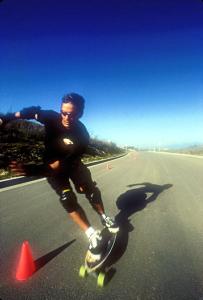 On the other hand life in the USA offers you life style benefits and possibilites you wouldn't find anywhere
else in the world. California especially is extremely multi ethnic and although racism and discrimination
can be found here as anywhere else in the world, there is no other place in the world that spreads its wealth
more evenly on a multi ethnic level as the US.
Here you must dream and follow your dream and things might just break. However it is also important to understand
that LA is extremely competitive and the best of the best come and reside here, trying to get that big break everyday.
Everybody wants to come here for that reason. For some it may happen quick, for most it may never happen. But one
thing is certain, this a place that is always seeking special skills and talent and is always looking for people
with ideas and originality. There is no other place like it! It doesn't matter where you are from or what color
your skin is as long as you are unique and persistent! You never feel like a stranger over here, life is more
laid back and the weather always inspires you to be outgoing and positive.
Before 9-11 people would always be interested in finding out where you are from beacuse of your accent or your
looks but in a positive way. Things are slowly getting back to normal again. I think in Europe you feel more
prejudism because of exactly those things--you are looked upon as a foreigner more often.
Here, it is easier to open doors career wise, especially if you are in a creative environment. Most people I know
make their living doing many different things, most of them have 2 or 3 jobs so that they can afford to support
their creative careers, it is hard work for most but the payoff can be more glamerous than enywhere else. Your
training and schooling don't weigh as much as in Europe--you can still be quite succesful in the US without a
college degree--something hard to imagine in Europe.
Connections are also very important over here but they are not that difficult to make as long as you have a
positive atitude and are outgoing. The dress code is also far more casual over here than in Europe, more relaxed,
shorts, t-shirts most of the time, all of these things take the serious edge out of your daily life, a quality
I value quite a bit.
On the other hand life in the USA offers you life style benefits and possibilites you wouldn't find anywhere
else in the world. California especially is extremely multi ethnic and although racism and discrimination
can be found here as anywhere else in the world, there is no other place in the world that spreads its wealth
more evenly on a multi ethnic level as the US.
Here you must dream and follow your dream and things might just break. However it is also important to understand
that LA is extremely competitive and the best of the best come and reside here, trying to get that big break everyday.
Everybody wants to come here for that reason. For some it may happen quick, for most it may never happen. But one
thing is certain, this a place that is always seeking special skills and talent and is always looking for people
with ideas and originality. There is no other place like it! It doesn't matter where you are from or what color
your skin is as long as you are unique and persistent! You never feel like a stranger over here, life is more
laid back and the weather always inspires you to be outgoing and positive.
Before 9-11 people would always be interested in finding out where you are from beacuse of your accent or your
looks but in a positive way. Things are slowly getting back to normal again. I think in Europe you feel more
prejudism because of exactly those things--you are looked upon as a foreigner more often.
Here, it is easier to open doors career wise, especially if you are in a creative environment. Most people I know
make their living doing many different things, most of them have 2 or 3 jobs so that they can afford to support
their creative careers, it is hard work for most but the payoff can be more glamerous than enywhere else. Your
training and schooling don't weigh as much as in Europe--you can still be quite succesful in the US without a
college degree--something hard to imagine in Europe.
Connections are also very important over here but they are not that difficult to make as long as you have a
positive atitude and are outgoing. The dress code is also far more casual over here than in Europe, more relaxed,
shorts, t-shirts most of the time, all of these things take the serious edge out of your daily life, a quality
I value quite a bit.
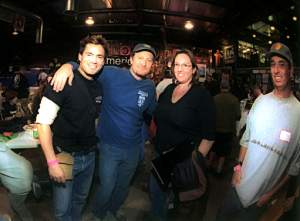 I don't follow the other types of skateboarding too closely. I live right around the corner from Val Surf, one
of the biggest skate shops in LA and go there frequently to buy hardware and stuff but I'm not into all the stuff
that's hanging on the walls or even the videos they constantly show.
But I think that skating, especially street and vert is on another level of performance and skills as I have ever
seen. The stuff kids do now is something I would have thought of as impossible back then. It is truly amazing what
they can do and with such ease. But when you see all the magazines and videos you'll realize that it is all pretty
much limited to rails and benches--after a while it all looks the same. You can see that skateboarding has become
very corporate and marketing driven.
It seems that street & vert skating has reached a platform which will remain for sometime but what is interesting
is that the skating scene is starting to change around those kids since we (us old slalom farts) are exposing
them to our sport, something they have never seen or thought about doing. This will only get better with the
release of the dogtown z-boys movie which will be out soon. More and more younger kids are getting stoked on
it--that's the reward!
I think the days when slalom is being shown on the monitor at Val Surf might
be closer than we think- that would be something!!!
I don't follow the other types of skateboarding too closely. I live right around the corner from Val Surf, one
of the biggest skate shops in LA and go there frequently to buy hardware and stuff but I'm not into all the stuff
that's hanging on the walls or even the videos they constantly show.
But I think that skating, especially street and vert is on another level of performance and skills as I have ever
seen. The stuff kids do now is something I would have thought of as impossible back then. It is truly amazing what
they can do and with such ease. But when you see all the magazines and videos you'll realize that it is all pretty
much limited to rails and benches--after a while it all looks the same. You can see that skateboarding has become
very corporate and marketing driven.
It seems that street & vert skating has reached a platform which will remain for sometime but what is interesting
is that the skating scene is starting to change around those kids since we (us old slalom farts) are exposing
them to our sport, something they have never seen or thought about doing. This will only get better with the
release of the dogtown z-boys movie which will be out soon. More and more younger kids are getting stoked on
it--that's the reward!
I think the days when slalom is being shown on the monitor at Val Surf might
be closer than we think- that would be something!!!
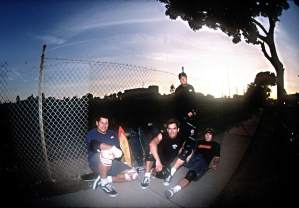 It is the older skaters whom have been bringing slalom back, true. There are skaters, who are 40+ years of
age. But some of those guys, including Henry Hester, Charlie Ransom and Steve Evans are seasoned enough to
take on anybody in any shape condition, anyday and give them a run for their money. Henry finished 8th at
La Costa in 2001 out of 90 racers and Steve Evans, whom I'm priviledged to ride with regularly is getting
into his legendary form, definitely a top 10 contender (worldwide) for this upcoming year. Also, Gary Cross
(I believe 42?) won the world championship last year!!!
In slalom the age is actually an added benefit as you are racing against the clock and strategy, brains
and experience are the deciding factor. This means knowing your opponent and how you can psyche him out,
know his weakness and use it to your advantage. Keeping a sharp and focussed mind will allow you to fly
out of the starting gates quicker. Here, it doesn't matter how high you ollie or how many kickflips you
can do. It's all about speed and keeping a good line on the course and keeping your cool. Even weight
can be of benefit to you. Some of the fastest skaters including my teammates Eric Groff (aka ARAB) and
Ritchie Carrasco weigh 200+ lbs!!! And they won't hold any punches, especially by old standards these
guys are faaast faster than I ever remember seeing! All this is important to show the younger kids out
there. It is important for them to see that as old timers we can kick their butts on any given day,
they love it and want to try and be a part of it. It just blows them away. The beauty in all of this
is that we are that little group inmidst the generation of youth that people are paying attention to.
Skateboarding is no longer for teens, its for all of us. It's all good fun and kids are
getting psyched on this whole thing, they see us set cones and just f...rip them and they go whooaaa, that's
f...' cool! That's all it takes. The range is now 8 years to about 51 and the young ones, especially guys like
Dillan Gordon and Josh Byrd (Team G&S) have to be seen to believe. Last year we all competed in the same
class, out of this world! This year there will be a youth division, amateur, pros and women's division
in most of the races. Its all about growing the sport and getting the kids involved is everything. I know
we're getting their attention and they are getting stoked on this whole thing!
It is the older skaters whom have been bringing slalom back, true. There are skaters, who are 40+ years of
age. But some of those guys, including Henry Hester, Charlie Ransom and Steve Evans are seasoned enough to
take on anybody in any shape condition, anyday and give them a run for their money. Henry finished 8th at
La Costa in 2001 out of 90 racers and Steve Evans, whom I'm priviledged to ride with regularly is getting
into his legendary form, definitely a top 10 contender (worldwide) for this upcoming year. Also, Gary Cross
(I believe 42?) won the world championship last year!!!
In slalom the age is actually an added benefit as you are racing against the clock and strategy, brains
and experience are the deciding factor. This means knowing your opponent and how you can psyche him out,
know his weakness and use it to your advantage. Keeping a sharp and focussed mind will allow you to fly
out of the starting gates quicker. Here, it doesn't matter how high you ollie or how many kickflips you
can do. It's all about speed and keeping a good line on the course and keeping your cool. Even weight
can be of benefit to you. Some of the fastest skaters including my teammates Eric Groff (aka ARAB) and
Ritchie Carrasco weigh 200+ lbs!!! And they won't hold any punches, especially by old standards these
guys are faaast faster than I ever remember seeing! All this is important to show the younger kids out
there. It is important for them to see that as old timers we can kick their butts on any given day,
they love it and want to try and be a part of it. It just blows them away. The beauty in all of this
is that we are that little group inmidst the generation of youth that people are paying attention to.
Skateboarding is no longer for teens, its for all of us. It's all good fun and kids are
getting psyched on this whole thing, they see us set cones and just f...rip them and they go whooaaa, that's
f...' cool! That's all it takes. The range is now 8 years to about 51 and the young ones, especially guys like
Dillan Gordon and Josh Byrd (Team G&S) have to be seen to believe. Last year we all competed in the same
class, out of this world! This year there will be a youth division, amateur, pros and women's division
in most of the races. Its all about growing the sport and getting the kids involved is everything. I know
we're getting their attention and they are getting stoked on this whole thing!
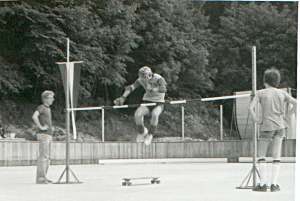 A year and half ago all you could find were classic slalom decks on ebay for top $$$. Trucks were limited
to classic trackers, indies and gullwings and wheels, even worse. That said, a complete pro setup could easily run $ 500!!!
Good things happened since, G&S started making slalom boards again, Turner came back from obscurity and Ick
(Rick Howell) just announced last week that new slalom boards are being made. In other words, after over
15 years of hiatus all the classic board manufacturers decide that it's time to produce again! Yeahh baby!!!
New companies such as Comet, Roe, V-12 have recently emerged as well as some of the newer promising slalom
deck manufacturers. In other words, there are more pro level slalom companies out there right now than ever
before and they are still emerging, why; because here is more demand. There is also a larger variety of
materials available which will only make the boards better. Credit must be given to the NCDSA for posting
skaters wishes and inquiries, people were listening!
Currently, design and materials have been mostly revolving around classic formulas and shapes that have been
in existence for a while. This includes the classic G&S maple/fibreglass sandwich type of construction and the
foam/glass type boards as the Icks/Turners and Roes. Comet, one of the newer companies has been very successful
by incorporating bamboo instead of maple into the laminates and also adding carbon fibre.
Each one of these boards has different energy and flex properties which is very specific and desirable by specific
riders. Not every board is for everybody. That said, I think new designs will keep emerging based on specific needs
from a variety of skaters. The concept and principle of a complete of a "quiver" will hold true for the future which
will only challenge new design concepts.
Tracker and Gullwing have announced new slalom trucks which is huge news in the skateboarding industry as molds
and development for trucks is extremely costly. This is a good sign for the sport and a barometer for the current
"slalom climate".
Same for wheels; V-12, Kryptonics, G&S, Comet, Turner and Abec-11 have all recently introduced new slalom wheels
which are far superior in terms of design and speed to most slalom wheels from the old days. Overall, a lot has
happened in a short period of time and things will keep happening as long as the demand is there. Right now there
is plenty of it.
A year and half ago all you could find were classic slalom decks on ebay for top $$$. Trucks were limited
to classic trackers, indies and gullwings and wheels, even worse. That said, a complete pro setup could easily run $ 500!!!
Good things happened since, G&S started making slalom boards again, Turner came back from obscurity and Ick
(Rick Howell) just announced last week that new slalom boards are being made. In other words, after over
15 years of hiatus all the classic board manufacturers decide that it's time to produce again! Yeahh baby!!!
New companies such as Comet, Roe, V-12 have recently emerged as well as some of the newer promising slalom
deck manufacturers. In other words, there are more pro level slalom companies out there right now than ever
before and they are still emerging, why; because here is more demand. There is also a larger variety of
materials available which will only make the boards better. Credit must be given to the NCDSA for posting
skaters wishes and inquiries, people were listening!
Currently, design and materials have been mostly revolving around classic formulas and shapes that have been
in existence for a while. This includes the classic G&S maple/fibreglass sandwich type of construction and the
foam/glass type boards as the Icks/Turners and Roes. Comet, one of the newer companies has been very successful
by incorporating bamboo instead of maple into the laminates and also adding carbon fibre.
Each one of these boards has different energy and flex properties which is very specific and desirable by specific
riders. Not every board is for everybody. That said, I think new designs will keep emerging based on specific needs
from a variety of skaters. The concept and principle of a complete of a "quiver" will hold true for the future which
will only challenge new design concepts.
Tracker and Gullwing have announced new slalom trucks which is huge news in the skateboarding industry as molds
and development for trucks is extremely costly. This is a good sign for the sport and a barometer for the current
"slalom climate".
Same for wheels; V-12, Kryptonics, G&S, Comet, Turner and Abec-11 have all recently introduced new slalom wheels
which are far superior in terms of design and speed to most slalom wheels from the old days. Overall, a lot has
happened in a short period of time and things will keep happening as long as the demand is there. Right now there
is plenty of it.
Back to the Sk8Mag.